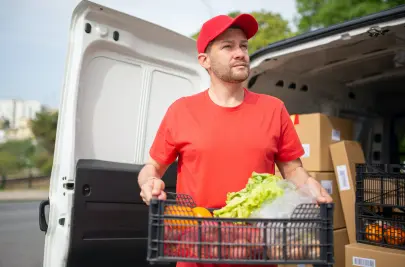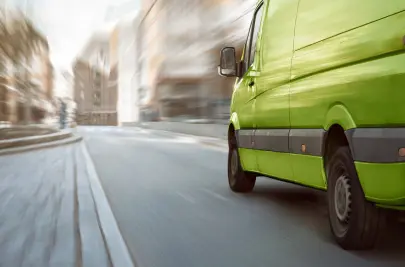
- Confused by a delivery notification?
- Not sure what a piece of last mile delivery jargon means?
- What is last mile delivery, anyway?
- We have the answers!
3PL
Short for Third Party Logistics. This term usually refers to companies that provide outsourced logistics services, including anything from packaging, warehousing, and local delivery to international shipping.
Well-known companies like Fedex, UPS, and DHL are 3PL providers. So is Fulfilment by Amazon, which manages the entire supply chain for many online businesses.
The advantages of using a 3PL service include:
- Less complexity. Supply chain operations can be extremely complex, especially when it comes to international shipping. For a lot of small and medium-sized businesses it makes more sense to hand these tasks over to experts, rather than try to hire their own logistics teams.
- Lower cost. Maintaining and managing warehouses and transportation fleets is expensive. By using 3PL providers, small businesses can benefit from their economies of scale and other efficiencies.
The disadvantages include a loss of visibility and control.
BOPIS
Short for Buy Online, Pick Up In Store. This is a popular alternative to delivery for a couple of reasons:
- Consumers and retailers avoid paying the costs of delivery.
- People can pick up their orders at a time and place that is convenient for them.
- It avoids all the problems associated with wrong addresses, missed deliveries, or package theft.
BOPIS is a good option for high-value items like electronics that can easily be stolen.

Carrier
A carrier is a company or government agency that transports material and people from one place to another: for example, postal services, courier companies, railways, or airlines.
In many countries there is a legal definition of “carrier”, and carriers are liable for the safe transport of the goods or people they are transporting. Some countries distinguish between private carriers, contract carriers, and common carriers. These usually operate under government license or regulation, and have the duty to provide certain services without discrimination (postal services are a good example).
Contactless delivery
A method of last mile delivery that eliminates physical contact between people. It became popular during the COVID-19 pandemic. Some businesses and consumers may still choose contactless delivery for reasons including health, privacy, and the convenience of not having to be physically present.
Read more: What Is No Contact Delivery?
Cost per delivery
A key metric for last-mile delivery companies. It’s easy to calculate: Just divide the number of deliveries made in a time period (a day, week, or month) by the cost of making those deliveries.

Lowering cost per delivery is the single most effective way that a delivery company can increase its profitability. Driver wages and fuel costs are the biggest components of delivery cost, but also very difficult to control. The most effective way to lower cost per delivery is to increase route density — in other words, to make more deliveries on each route. This can be done by using route optimization software.
Read more: Last Mile Delivery Costs — Challenges and Solutions
Customer notifications
Messages sent by SMS, email, or inside an app to keep a customer informed about the status of their delivery order. Common notifications include:
- Confirmation that the order has been placed and paid for.
- Confirmation that the order has been shipped.
- Estimated time of delivery.
- Confirmation that the order has been delivered.
Read more: Delivery Notifications: A Complete Guide For Businesses And Consumers
ETA / ETD
Estimated time of arrival or estimated time of delivery. When a business communicates a clear ETD to a customer who is expecting a delivery, it’s easier for the customer to plan their time — which makes calculating an accurate ETA an important component of a great customer experience.
Calculating and communicating ETAs is a significant benefit offered by delivery management software and route optimization software.
Read more: ETA vs ETD: What's the difference?
Geocoding
Geocoding is the process of converting an address to an exact set of geographical coordinates, usually expressed in latitude and longitude, that can be plotted on a map.
In last mile delivery, accurate geocoding is important because it can help to avoid delays and missed deliveries. For example, let’s say a delivery needs to be made to an office building at 220 Cambie Street in Vancouver. In the image below, you can see the difference when the address is geocoded to the middle of the building vs the street entrance. In the first case, the driver ends up being routed to an alleyway with no parking and no entrance to the building. In the second case, they get sent straight to the entrance.

Big buildings often have multiple entrances: For example, a loading bay might be on a completely different street from the main entrance. Correctly locating the right spot during route planning can save a lot of time. Even a few minutes spent circling around the block adds up over a day! More accurate geocoding can translate into more deliveries per day, which lowers cost per delivery.

Ghost kitchen
A professional kitchen which only prepares meals for delivery, not for serving directly to customers. Also called dark kitchens, cloud kitchens or virtual restaurants. A single ghost kitchen might cook for several different restaurants, with different menus and branding.
Ghost kitchens have grown along with food delivery apps like Doordash, Uber Eats, Deliveroo, Grubhub, etc. They also got a boost in popularity during the COVID-19 pandemic when dine-in restaurants closed.
The dark kitchen model can be profitable for food service businesses, because it eliminates all the costs associated with having a dining room and serving staff.

Last mile
In logistics and telecommunications, the last mile is the final link in the chain that delivers goods or services to end customers. For example, delivering a package from a warehouse or depot to the customer’s door is a last-mile delivery.
The last mile is the most expensive part of the supply chain, because there are no economies of scale. Instead of a thousand identical packages being sent by truck, rail, or ship to a single destination, it involves many individual packages, of many different sizes, shapes, and weights, being sent to many different addresses.
Last mile deliveries can be made by truck, van, bicycle, scooter, drone or even on foot. The choice of delivery method depends partly on how dense the delivery area is, which determines the distance that needs to be traveled.
On-time delivery
An important performance indicator for delivery businesses. A higher on-time delivery rate is a sign of efficient operations, and tends to increase customer satisfaction and loyalty.
Methods for improving the on-time delivery rate include:
- Inventory planning and warehouse management to ensure products are in stock and easy to find when needed.
- Using delivery management and route optimization software to calculate efficient delivery routes and accurate times.
Read more: Beat the Clock: How Businesses Can Improve On-Time Delivery
Proof of delivery
A document or digital record that confirms a package has been delivered to its recipient. Common forms of proof of delivery (POD) include signatures, photographs, and barcode scans.
Read more: Proof Of Delivery: A Guide for Businesses & Consumers
Route density
Route density refers to the number of deliveries or stops that a driver can complete per hour. Higher route density — more stops per hour — means lower cost per delivery, and increased profitability. One of the main goals of route optimization is to increase route density.
Location is a big factor in route density. An urban area with multiple deliveries on a single block enables much higher route density than a rural area with miles between stops. But in general, these are useful route density benchmarks to know:
- Below three deliveries per hour is poor performance.
- Three to six deliveries per hour is average.
- Seven or more deliveries per hour is excellent.
Large couriers like Fedex or UPS can achieve 10-20 deliveries per hour, but this is only possible with their large volumes.
Route optimization
The use of algorithms to calculate the most efficient route for visiting a certain number of locations (known as the Traveling Salesman Problem).
Route optimization can cut travel times and distances by 20-30%, resulting in efficiency gains and lower costs. It’s especially valuable for delivery businesses, sales staff, and field service technicians.
Read more: Ultimate Guide to Route Optimization
Spaghetti routes
Spaghetti routes are messy, tangled delivery routes that often criss-cross or loop back on themselves. They’re the result of route optimization algorithms planning routes that are mathematically efficient, but don’t make sense to humans.
Take a look at the two circled areas in this screenshot:

- Circle A includes two stops from the red and blue routes that could easily be part of the purple route.
- In circle B, four separate drivers are being sent to the same area. Two teal stops, marked 2 and 4, are almost right next door to stops on the purple and orange routes.
Spaghetti routes are a common cause of complaints from delivery drivers. When you see one of your colleagues leaving a neighborhood just as you are driving into it, that doesn’t make sense.
At Routific, we’re building our algorithm to take human preferences into account.
Shipping
The difference between shipping and delivery is easiest to explain if you think about them as being at opposite ends of the supply chain. The shipping process is everything involved in sending an item from its point of origin to the person who has bought it. The very final stage, delivery, is when the customer receives the item they've paid for.
Another way of putting it is that the shipping process includes the first mile and middle mile of the supply chain; delivery is all about the last mile.
Read more: Shipping vs Delivery: What's The Difference?
Sorting center
A sorting center (also called a parcel sorting facility, processing center, or distribution center) is a warehouse or other place where packages and parcels get sorted and organized for delivery to their final destinations.
In last mile delivery, you’re more likely to find people talking about distribution centers. This is because sorting centers are also involved in the first mile of delivery. Goods are moved from the factory to a facility where they are sorted based on their final destination region.
The largest sorting center in the world is UPS Worldport in Kentucky. In 2020 it processed 416,000 shipments every hour!
If you get a notification saying that a package has been “dispatched from sorting center” it just means your package has been processed, and sent on to the next phase of delivery. This could mean it’s been loaded onto a vehicle for delivery to your doorstep, or just that it’s been sent from one big sorting center to another one, closer to you.
Time windows
In last mile delivery, a time window or delivery slot is the period of time within which a delivery is planned to happen. A time window could be a day, a few hours, or as little as 30 minutes. Some businesses allow their customers to choose their own delivery time windows; others just announce the window after the delivery has been planned.
In general, shorter delivery time windows lead to higher customer satisfaction. A delivery promised “on Tuesday” is a lot more vague and hard to plan for, compared to a delivery “between 10am and 12pm on Tuesday”.
Read more: How To Offer Convenient Delivery Time Windows
White glove delivery
A value-added delivery service that may include: special packaging and handling for delicate or expensive items, assembling furniture, setting up equipment, or unpacking and then removing packaging materials.
Read more: Understanding White Glove Delivery: What Is It, And Who Should Use It In Their Business?
WISMO
Short for “where is my order?”. This is one of the most frequent customer questions in shipping and delivery businesses, and it can be expensive to answer.
Businesses can reduce the number of WISMO queries they deal with by providing tracking numbers, sending delivery notifications and updates, and sharing live tracking links when an order is out for delivery.
Frequently Asked Questions
Related articles
Liked this article? See below for more recommended reading!

Last Mile Delivery Costs — Challenges and Solutions

Best Last Mile Delivery Software 2025: Reviews & Guide



